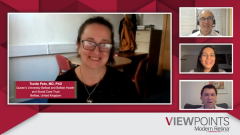
Inherited Retinal Disease: Treatment Overview
Dr Mariya Moosajee highlights therapies approved as well as under study to improve treatment for patients with inherited retinal disease.
Episodes in this series

Albert J. Augustin, MD: We have to move forward. I’d like to ask Dr Moosajee for her opinion on the treatment options for inherited diseases.
Mariya Moosajee, MBBS, BSc, PhD, FRCOphth: Thank you. There aren’t many treatment options for patients with IRD [inherited retinal disease]. Conservative management is important; we give a lot of advice about the diet of these patients, such as fresh fruits and vegetables. We know from studies in animal models that there are high levels of oxidative stress in the retina. Therefore, we’re advocating that patients eat fruits that are red, blue, and black and that are rich in antioxidants, such as grapes, raspberries, pomegranates, and strawberries. We ask patients to wear UV [ultraviolet] sunglasses in bright light to protect the retina from any further sun damage. In a lot of IRDs, you can get macular edema; those patients may be put on Diamox [acetazolamide] or Trusopt [dorzolamide] just to help manage that. But we now have the first approved retinal gene therapy targeted toward gene RPE65, which causes leber congenital amaurosis phenotype and also retinitis pigmentosa. This is called voretigene neparvovec and is widely available across the world. I’ve the seen the results of some of the real-life patients being treated with this, especially in the pediatric cohort. We’re seeing increases in best-corrected visual acuity and improvements in the navigational vision and in the vision in dim light. There are some inherited retinal diseases, such as gyrate atrophy, which is an autosomal recessive disease caused by mutations in the OAT gene. This encodes an enzyme that’s active in our mitochondria to help break down ornithine. If we identify these mutations and we also advise our patients to take a diet that’s arginine restricted to reduce ornithine intake, this can potentially prevent further retinal degeneration. There are several clinical trials underway for gene replacement therapies; we’re hoping to see an increase in availability of treatments to this cohort of patients in the coming years.
Albert J. Augustin, MD: Thank you. Maybe you can add a little bit on subretinal injection of gene therapy since we are already speaking about gene therapy in inherited diseases.
Mariya Moosajee, MBBS, BSc, PhD, FRCOphth: At the moment, the way that we deliver the gene therapy is through subretinal injection. This involves patients having a vitrectomy and then subretinal injection where you have the intact retina and have the injection of adeno-associated viral vectors, which package the RPE65 gene. We know from clinical trials that there can be some adverse ocular inflammatory events associated with this, so patients are given steroids, pre-, peri-, and postoperatively to try to dampen that response. Gene therapy is a single administration to both eyes. There are concerns: What if there’s a loss of efficacy possibly through neutralizing antibodies? What if we need to consider redosing these patients? Will there be an immune response because the eye has already been almost immunized towards this AAV [adeno-associated virus] vector? These are things we have to bear in mind. There’s also surgical iatrogenic damage that could be seen with these patients. Especially in choroideremia gene therapy trials, when you have a very small central island of potentially friable tissue, you can cause retinal stretch and thinning from a subretinal injection. There’s a lot of research being undertaken to think about other ways we can tackle these problems. There’s a company called 4D Molecular Therapeutics that has undertaken massive high throughput screens looking for evolved AAV vectors that are better at penetrating cells and targeting particular cell types, like photo receptors or RPE. They’re testing whether these vectors can be delivered through the intravitreal route, therefore avoiding subretinal injections. There’s a phase 1 clinical trial underway for choroideremia, particularly delivering the CHM gene through an intravitreal route. We’ll have to wait and see what the results show.
Albert J. Augustin, MD: Thank you very much.
Transcript edited for clarity.
Newsletter
Get the essential updates shaping the future of pharma manufacturing and compliance—subscribe today to Pharmaceutical Technology and never miss a breakthrough.









